Conservation Breeding at the DLC
On April 12, 2018, a baby blue-eyed black lemur takes her first breath. This moment has been three years – arguably, fifty years – in the making. The baby, Ranomasina, is born via C-section at the Duke Lemur Center to parents Velona and Mangamaso, who arrived from a zoo in Madagascar in September 2017. Theirs is one critical chapter in the story of lemur conservation at the DLC. Though all baby lemurs are important (and adorable!), Ranomasina represents years of work to protect the critically endangered blue-eyed black lemur from extinction.
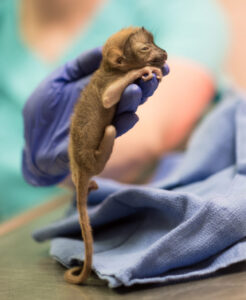
Baby Ranomasina moments after her birth.
At the time of her birth, only thirty-three others of her species were living in human care in North America, and all were descended from the same seven individuals that were brought over from Madagascar in 1985 and 1990. After twenty-four years, including three years of arduous planning, Velona and Mangamaso brought over a new genetic line to bolster the conservation breeding population. Their journey was part of a global exchange, in which the DLC sent a pair of blue-eyed black lemurs to France, and Parc Ivoloine in Madagascar (where Mangamaso and Velona were born) received another pair from a different Malagasy institution. While this exchange was unique, hard-earned, and crucial to the conservation of blue-eyed black lemurs, it is not the only major conservation breeding achievement the Duke Lemur Center has seen in its fifty-five years of work.
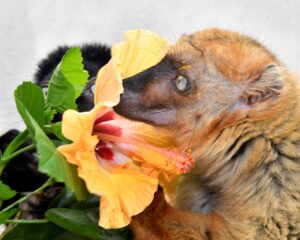
Velona and Mangamaso enjoy hibiscus flowers at the DLC.
When lemurs first began living in the Duke Forest in 1966, conservation breeding was not yet a consideration. It wasn’t until the 1970s and 80s that director Elwyn Simons began to conceptualize the DLC as a genetic safety net for the threatened lemurs of Madagascar. After obtaining permission from the Malagasy government, the first wild-caught, Madagascar-born aye-ayes arrived at the DLC in 1987. A few years and a few capture missions later, staff welcomed the first aye-aye ever born in human care, Blue Devil. Blue Devil’s birth signaled the start of a new era at the Duke Lemur Center and in the world –conservation breeding in human care could be a way to help save lemurs in the wild. Today, there are approximately 30 aye-ayes living and breeding in facilities around the world, bolstering the populations of their rare and endangered wild relatives in Madagascar.
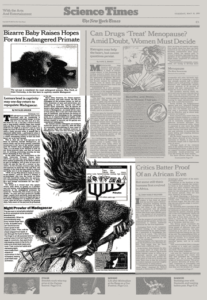
Blue Devil was the first ever aye-aye infant born in human care.
The Duke Lemur Center’s conservation breeding program has come a long way since Blue Devil’s birth. Overall, the DLC has welcomed 3,285 new babies into the world since 1966, from some of the rarest primate species on earth. But we haven’t done it alone. The DLC is accredited by the Association of Zoos and Aquariums, an organization which holds its accredited institutions to standards of excellence in animal care and welfare, public engagement, and species conservation. As part of the AZA’s mission, conservation breeding management plans like the Species Survival Plan (SSP) assist in maintaining genetic diversity and population health in captive wildlife. Because the SSP deals with endangered species, there may not be a high number of representative individuals in human care, which can limit breeding possibilities. The SSP can help animal care facilities pair up the most genetically distinct individuals at their own facilities or set up a transfer between different accredited institutions for better breeding possibilities. In addition, the Taxon Advisory Groups for each species will help institutions make the best possible decisions for the health, wellbeing, and comfort of the specific animals in their care.
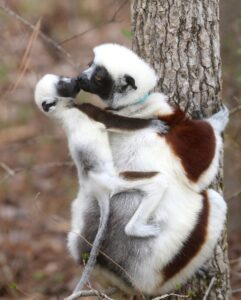
Coquerel’s sifaka mom Lupicina checks on baby Felix as they explore their forest enclosure at the DLC.
The overall goal of conservation breeding programs like the SSP is to create a genetic safety net for endangered species. This safety net becomes more and more important as wild populations decline. The Duke Lemur Center was able to successfully reintroduce a group of black and white ruffed lemurs to Madagascar in the 1980s, which solidifies the importance of maintaining a breeding population in human care—captive-bred species can be reintroduced back into the wild to bolster the struggling native populations, helping protect them from extinction. But there are additional successes to maintaining a breeding population in human care. Researchers and veterinarians like those at the DLC are able to learn more about lemurs than ever before, and these life-saving breakthroughs can be directly applied to the support of wild populations. Of course, a major player in the conservation of species are the countless visitors to centers like the DLC who are able to witness the work being done to save lemurs and add their support to the cause. It can be a life-changing experience to see a baby lemur up close, not only because of how cute they are, but because of what they signify –survival against all odds, and the importance of saving species by any means possible.
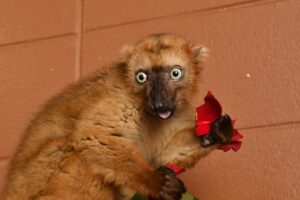
Ranomasina munches on a flower snack. This spunky three year old is ready for a sibling to play with!
This spring, the DLC is welcoming more new babies to the world. Ranomasina is preparing to be a big sister, which is a very important job – almost as important as representing and reinforcing the survival of her species. She’s totally up for the challenge.

